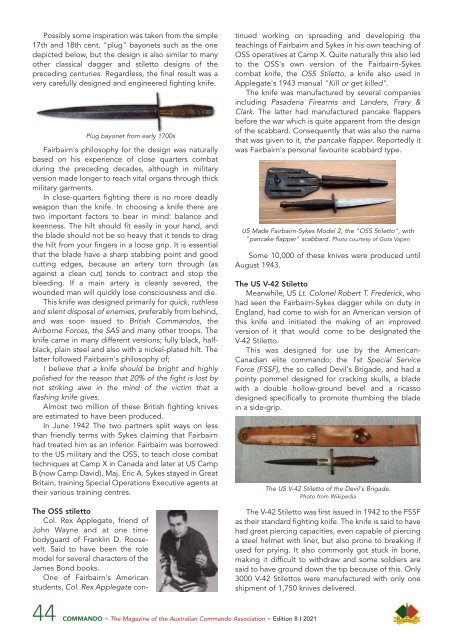Commando News Magazine edition 8 2021
Create successful ePaper yourself
Turn your PDF publications into a flip-book with our unique Google optimized e-Paper software.
Possibly some inspiration was taken from the simple<br />
17th and 18th cent. "plug" bayonets such as the one<br />
depicted below, but the design is also similar to many<br />
other classical dagger and stiletto designs of the<br />
preceding centuries. Regardless, the final result was a<br />
very carefully designed and engineered fighting knife.<br />
Plug bayonet from early 1700s<br />
Fairbairn's philosophy for the design was naturally<br />
based on his experience of close quarters combat<br />
during the preceding decades, although in military<br />
version made longer to reach vital organs through thick<br />
military garments.<br />
In close-quarters fighting there is no more deadly<br />
weapon than the knife. In choosing a knife there are<br />
two important factors to bear in mind: balance and<br />
keenness. The hilt should fit easily in your hand, and<br />
the blade should not be so heavy that it tends to drag<br />
the hilt from your fingers in a loose grip. It is essential<br />
that the blade have a sharp stabbing point and good<br />
cutting edges, because an artery torn through (as<br />
against a clean cut) tends to contract and stop the<br />
bleeding. If a main artery is cleanly severed, the<br />
wounded man will quickly lose consciousness and die.<br />
This knife was designed primarily for quick, ruthless<br />
and silent disposal of enemies, preferably from behind,<br />
and was soon issued to British <strong>Commando</strong>s, the<br />
Airborne Forces, the SAS and many other troops. The<br />
knife came in many different versions; fully black, halfblack,<br />
plain steel and also with a nickel-plated hilt. The<br />
latter followed Fairbairn's philosophy of;<br />
I believe that a knife should be bright and highly<br />
polished for the reason that 20% of the fight is lost by<br />
not striking awe in the mind of the victim that a<br />
flashing knife gives.<br />
Almost two million of these British fighting knives<br />
are estimated to have been produced.<br />
In June 1942 The two partners split ways on less<br />
than friendly terms with Sykes claiming that Fairbairn<br />
had treated him as an inferior. Fairbairn was borrowed<br />
to the US military and the OSS, to teach close combat<br />
techniques at Camp X in Canada and later at US Camp<br />
B (now Camp David). Maj. Eric A. Sykes stayed in Great<br />
Britain, training Special Operations Executive agents at<br />
their various training centres.<br />
The OSS stiletto<br />
Col. Rex Applegate, friend of<br />
John Wayne and at one time<br />
bodyguard of Franklin D. Roose -<br />
velt. Said to have been the role<br />
model for several characters of the<br />
James Bond books.<br />
One of Fairbairn's American<br />
students, Col. Rex Applegate con -<br />
tinued working on spreading and developing the<br />
teachings of Fairbairn and Sykes in his own teaching of<br />
OSS operatives at Camp X. Quite naturally this also led<br />
to the OSS's own version of the Fairbairn-Sykes<br />
combat knife, the OSS Stiletto, a knife also used in<br />
Applegate's 1943 manual "Kill or get killed".<br />
The knife was manufactured by several companies<br />
including Pasadena Firearms and Landers, Frary &<br />
Clark. The latter had manufactured pancake flappers<br />
before the war which is quite apparent from the design<br />
of the scabbard. Consequently that was also the name<br />
that was given to it, the pancake flapper. Reportedly it<br />
was Fairbairn's personal favourite scabbard type.<br />
US Made Fairbairn-Sykes Model 2, the "OSS Stiletto", with<br />
"pancake flapper" scabbard. Photo courtesy of Gota Vapen<br />
Some 10,000 of these knives were produced until<br />
August 1943.<br />
The US V-42 Stiletto<br />
Meanwhile, US Lt. Colonel Robert T. Frederick, who<br />
had seen the Fairbairn-Sykes dagger while on duty in<br />
England, had come to wish for an American version of<br />
this knife and initiated the making of an improved<br />
version of it that would come to be designated the<br />
V-42 Stiletto.<br />
This was designed for use by the American-<br />
Canadian elite commando; the 1st Special Service<br />
Force (FSSF), the so called Devil's Brigade, and had a<br />
pointy pommel designed for cracking skulls, a blade<br />
with a double hollow-ground bevel and a ricasso<br />
designed specifically to promote thumbing the blade<br />
in a side-grip.<br />
The US V-42 Stiletto of the Devil's Brigade.<br />
Photo from Wikipedia<br />
The V-42 Stiletto was first issued in 1942 to the FSSF<br />
as their standard fighting knife. The knife is said to have<br />
had great piercing capacities, even capable of piercing<br />
a steel helmet with liner, but also prone to breaking if<br />
used for prying. It also commonly got stuck in bone,<br />
making it difficult to withdraw and some soldiers are<br />
said to have ground down the tip because of this. Only<br />
3000 V-42 Stilettos were manufactured with only one<br />
shipment of 1,750 knives delivered.<br />
44 COMMANDO ~ The <strong>Magazine</strong> of the Australian <strong>Commando</strong> Association ~ Edition 8 I <strong>2021</strong>
















